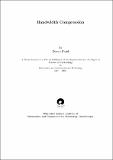Please use this identifier to cite or link to this item:
http://drsr.daiict.ac.in//handle/123456789/126| Title: | Bandwidth compression |
| Authors: | Sahasrabudhe, S. C. Patel, Deven |
| Keywords: | Bandwidth compression television Television bandwidth compression |
| Issue Date: | 2006 |
| Publisher: | Dhirubhai Ambani Institute of Information and Communication Technology |
| Citation: | Patel, Deven (2006). Bandwidth compression. Dhirubhai Ambani Institute of Information and Communication Technology, vii, 35 p. (Acc.No: T00089) |
| Abstract: | Bandwidth compression implies a reduction in bandwidth of an information carrying signal without reducing the information content of the signal. Methods such as PCM, DPCM and other redundancy removal algorithms rely on the sample-by-sample values of the signal. The work described in the thesis looks at the possibilities of encoding the sequences using shorter description, based on their second order moments. A Markov model is the simplest realization of an information source. As proved by the Asymptotic Equipartition Property [Sha48], not all sequences are produced with the same probability by such a source. Only a fraction of the total sequences is produced with a high probability. The number of these high probability sequences decide the number of bits required to represent these sequences. The number of these sequences are calculated for different models. An estimate of autocorrelation for lag 1 of these sequences is then made. The results then show that the bit rate reduction increases with the correlation coefficient. |
| URI: | http://drsr.daiict.ac.in/handle/123456789/126 |
| Appears in Collections: | M Tech Dissertations |
Files in This Item:
| File | Description | Size | Format | |
|---|---|---|---|---|
| 200411028.pdf Restricted Access | 267.03 kB | Adobe PDF |  View/Open Request a copy |
Items in DSpace are protected by copyright, with all rights reserved, unless otherwise indicated.
